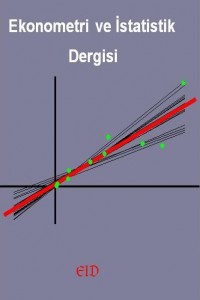Abstract
Günümüzde ham petrol fiyatlarındaki oynaklık, finansal piyasalarda çalışan uzmanların kaygı ile izledikleri
önemli gelişmelerden biridir. Son zamanlarda yaşanan ham petrol fiyatlarındaki artış, tükettiği enerjinin
%40’ını petrolden karşılayan ve tükettiği petrolün %90’ını ithal eden bir ülke olan Türkiye ekonomisi için
oldukça önemli hale gelmiştir. Çalışmanın amacını, ham petrol varil fiyatı serisinin oynaklık gösterip
göstermediklerinin, gösteriyorsa oynaklıklarının yapısının, büyüklüğünün ve sürekliliğinin incelenmesi
oluşturmaktadır. Ayrıca bu iktisadi değişkenler için oynaklığın yapısını belirleyen en uygun müdahale modeli
elde edilmeye çalışılmıştır. Ocak 1981 - Aralık 2007 dönemi verileri ele alındığında, zaman serisinin durağan
olmadığı yapılan birim kök testleri sonucunda görülmüştür. Seride müdahalelerin varlığı nedeniyle serinin
durağan dışı olduğu düşüncesiyle seriye müdahale analizi uygulanmıştır. Seride muhtemel üç müdahale olduğu
düşünülerek yapılan müdahale analizi sonucunda, sadece bir müdahale değişkeni anlamlı çıkmıştır. Bu
analizler sırasında, çeşitli aşamalarda SAS/ETS, Minitab 14 ve Eviews 5.1 kullanılmıştır. Anlamlı çıkan IrakABD
kaosu müdahale değişkeni ile petrol fiyatları serisinin gecikmeli değerlerinden ekonometrik bir model
oluşturulmaya çalışılmıştır.
References
- ABRAHAM, B. (1980), “Intervention analysis and multiple time series”, Biometrika, 67(1), 73-78
- BOX, G.E. ve TIAO, G.C. (1975), “Intervention analysis with applications to economic and environmental problems”, JASA, 70, 70-79
- BRUNO, M. (1982), “Adjustment and structural change under supply shocks”, Scandinavian Journal of Economics, 84, 199-221
- BRUNO, M. ve SACHS, J. (1981), “Supply versus demand approaches to the problem of stagflation”, in Macroeconomic Policies for Growth and Stability (Kieal: Institute für Weltwirtschaft)
- DARBY, M. (1982), “The price of oil and world inflation and recession”, American Economic Review, 72, 738- 751
- DEES S.,KARADELOGLOU P., KAUFMAN R. ve SANCHEZ M. (2007), “Modelling the Oil Market, Assessment of quarterly econometric model”, Energy Policy, 35,178-191
- ENDERS, W. (1995), Applied Econometric Time Series. John Wiley & Sons Inc. Canada
- FOROUTAN, F. ve MOSHIRI, S. (2006), “Forecasting nonlinear crude oil futures prices”, The Energy Journal
- HARKNESS, J. (1982) “Intermediate imports, expectations, and stochastic equilibrium under flexible Exchange rates”, Canadian Journal of Economics, 15, 118-143
- HUDSON, B. (2008), A review of EIA’s Annual Energy Outlook 2008
- KOCENDA, E. (2005), “Beware of breaks in Exchange rates: Evidence from European Transition Countries” Economic System, 29(3), 307-324
- LYNCH, M. (2003), “Causes of oil price volatility”, 8th International Energy Forum, 21-23 September, Osaka, Japan
- MABRO, R. (2002), “On oil price regimes and price volatility” 8th International Energy Forum, 21-23 September, Osaka, Japan
- MANERA, M., LONGO, C., MARKANDYA, A. ve SCARPA, E. (2007), “Evaluating the Empirical Performance of Alternative Econometric Models for Oil Price Forecasting”, FEEM Working Paper No. 4.2007
- MAZRAATI, M ve JAZAYERI, S. (2004), “Oil price movements and production agreements” 2004 Organization of the Petroleum Exporting Countries
- MORK, K. A. ve HALL R. E. (1980), “Energy prices, inflation and recession, 1974-1975”, The Energy Journal of Economics, 84, 147-159
- TIAO, G.C. ve BOX, G.E. (1981), “Modelling multiple time series with applications, JASA, 76, 802-816
- WEI, W.S. (1990), Time Series Analysis: Univariate and Multivariate Methods, Addison-wesley, Redwood city
Abstract
References
- ABRAHAM, B. (1980), “Intervention analysis and multiple time series”, Biometrika, 67(1), 73-78
- BOX, G.E. ve TIAO, G.C. (1975), “Intervention analysis with applications to economic and environmental problems”, JASA, 70, 70-79
- BRUNO, M. (1982), “Adjustment and structural change under supply shocks”, Scandinavian Journal of Economics, 84, 199-221
- BRUNO, M. ve SACHS, J. (1981), “Supply versus demand approaches to the problem of stagflation”, in Macroeconomic Policies for Growth and Stability (Kieal: Institute für Weltwirtschaft)
- DARBY, M. (1982), “The price of oil and world inflation and recession”, American Economic Review, 72, 738- 751
- DEES S.,KARADELOGLOU P., KAUFMAN R. ve SANCHEZ M. (2007), “Modelling the Oil Market, Assessment of quarterly econometric model”, Energy Policy, 35,178-191
- ENDERS, W. (1995), Applied Econometric Time Series. John Wiley & Sons Inc. Canada
- FOROUTAN, F. ve MOSHIRI, S. (2006), “Forecasting nonlinear crude oil futures prices”, The Energy Journal
- HARKNESS, J. (1982) “Intermediate imports, expectations, and stochastic equilibrium under flexible Exchange rates”, Canadian Journal of Economics, 15, 118-143
- HUDSON, B. (2008), A review of EIA’s Annual Energy Outlook 2008
- KOCENDA, E. (2005), “Beware of breaks in Exchange rates: Evidence from European Transition Countries” Economic System, 29(3), 307-324
- LYNCH, M. (2003), “Causes of oil price volatility”, 8th International Energy Forum, 21-23 September, Osaka, Japan
- MABRO, R. (2002), “On oil price regimes and price volatility” 8th International Energy Forum, 21-23 September, Osaka, Japan
- MANERA, M., LONGO, C., MARKANDYA, A. ve SCARPA, E. (2007), “Evaluating the Empirical Performance of Alternative Econometric Models for Oil Price Forecasting”, FEEM Working Paper No. 4.2007
- MAZRAATI, M ve JAZAYERI, S. (2004), “Oil price movements and production agreements” 2004 Organization of the Petroleum Exporting Countries
- MORK, K. A. ve HALL R. E. (1980), “Energy prices, inflation and recession, 1974-1975”, The Energy Journal of Economics, 84, 147-159
- TIAO, G.C. ve BOX, G.E. (1981), “Modelling multiple time series with applications, JASA, 76, 802-816
- WEI, W.S. (1990), Time Series Analysis: Univariate and Multivariate Methods, Addison-wesley, Redwood city
Details
| Primary Language | Turkish |
|---|---|
| Journal Section | Makaleler |
| Authors | |
| Publication Date | March 17, 2011 |
| Published in Issue | Year 2010 Issue: 12 |


